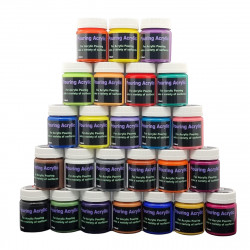Turbo Cell
Availability:
- Potent Cell Former for Acrylic Pouring Art in most traditional fluid art techniques and is also used in the chameleon cell technique.
- More effective than standard Silicone Oil. While it may be referred to as a cell activator, it should not be confused with our Cloud & Pearl and Cell Activator Flow Control products that create cells in advanced techniques without any oily additives.
- Can be used to create lacing and cells in resin art.
Turbo Cell in Fluid Art
Background
Many traditional Acrylic Pouring techniques use a cell forming chemical to generate cells. Traditional techniques include flip cup pours, straight pours, dirty pours, puddle pours, ring pours, open cup pours, kiss pours, string and chain pull pours, split cup pours, swipes, Dutch pours and others. There are numerous variations of these techniques, many of which have their own names. To form cells in most of these techniques, add a little silicone or Turbo Cell to some or all of the colours after mixing the paints with our Original Flow Control. Turbo Cell is also excellent in chameleon cell techniques.
About Turbo Cell and how to use it
Turbo Cell is manufactured by Bastion Paint and is a potent cell forming product for acrylic pouring art. It is supplied in convenient dropper bottles so is easy to use. Two drops of Turbo Cell added to 40ml of the Paint/Original Flow Control mix will generate excellent cells. Add Turbo Cell after mixing the paint well with Original Flow Control. Once the paint flow (also referred to as thickness or consistency) is correct then add Turbo Cell to some or all of the colours to be used in the pour. Don’t stir in the Turbo Cell, just give it a quick swirl.
In the chameleon cell technique, Turbo Cell is dotted into layered paints using a toothpick or similar item.
As with other cell forming chemicals, the surface of the dried art will have to be cleaned to remove oily residue before applying any subsequent topcoat.
Videos
The following video shows an alternative method of using Turbo Cell to create cells in an acrylic pour (just 2 minutes).
Turbo Cell in Spiral Straight Pour - short video: Click to Watch
Turbo Cell compared to Silicone Oil
Turbo Cell surpasses the cell forming ability of benchmark silicone oil in Acrylic Pouring Art.
Turbo Cell gives superior and somewhat different results to silicone oil. It creates more cells within cells than silicone oil because it forms cells via two mechanisms whereas silicone oil just has a single cell forming mechanism. Cells form immediately and torching is not required to generate cells. You can still torch to remove air bubbles if required.
We do, however, also supply Silicone Oil. As our Silicone Oil is 100% pure, many artists achieve excellent results with it and prefer to stick with what they know. But we will always recommend Turbo Cell.
Turbo cell in Resin Art
Obtaining cells in resin art can be quite tricky. We have used Turbo Cell to generate cells in white waves as can be seen in the video. Oil and resin do not like each other so always be careful using them together. It is, however, the fact that they don’t like each other that creates the cells.
Use 1 drop in 30ml of one colour resin that is poured over another colour before it starts to harden. Pour top colour (with Turbo Cell) in a thin stripe and blow it horizontally into the lower colour with a torch. Cells and fine lacing form.
Video
Type |
|
| Type | |
General |
|
| Colour | |
| Unit Size |
30ml
100ml
300ml
|
Cup Type |
|
| Cup Type | |
Unit Size |
|
| Unit Size | |
Glass Size |
|
| Glass Size / Colour | |
Unit Size |
|
| Unit Size | |








 Mixing Paints for Acrylic Pouring
Mixing Paints for Acrylic Pouring





